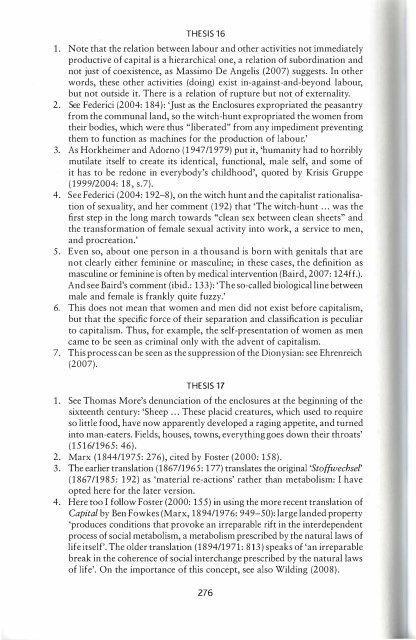CRACK CAPITALISM
Holloway - Crack Capitalism
Holloway - Crack Capitalism
- No tags were found...
Create successful ePaper yourself
Turn your PDF publications into a flip-book with our unique Google optimized e-Paper software.
THESIS 16<br />
1. Note that the relation between labour and other activities not immediately<br />
productive of capital is a hierarchical one, a relation of subordination and<br />
not just of coexistence, as Massimo De Angelis (2007) suggests. In other<br />
words, these other activities (doing) exist in-against-and-beyond labour,<br />
but not outside it. There is a relation of rupture but not of externality.<br />
2. See Federici (2004: 184): 'Just as the Enclosures expropriated the peasantry<br />
from the communal land, so the witch-hunt expropriated the women from<br />
their bodies, which were thus "liberated" from any impediment preventing<br />
them to function as machines for the production of labour.'<br />
3. As Horkheimer and Adorno (1947/1979) put it, 'humanity had to horribly<br />
mutilate itself to create its identical, functional, male self, and some of<br />
it has to be redone in everybody's childhood', quoted by Krisis Gruppe<br />
(1999/2004: 18, s.7).<br />
4. See Federici (2004: 192-8 ), on the witch hunt and the capitalist rationalisation<br />
of sexuality, and her comment (192) that 'The witch-hunt ... was the<br />
first step in the long march towards "clean sex between clean sheets" and<br />
the transformation of female sexual activity into work, a service to men,<br />
and procreation.'<br />
5. Even so, about one person in a thousand is born with genitals that are<br />
not clearly either feminine or masculine; in these cases, the definition as<br />
masculine or feminine is often by medical intervention (Baird, 2007: 124f£').<br />
And see Baird's comment (ibid.: 133): 'The so-called biological line between<br />
male and female is frankly quite fuzzy.'<br />
6. This does not mean that women and men did not exist before capitalism,<br />
but that the specific force of their separation and classification is peculiar<br />
to capitalism. Thus, for example, the self-presentation of women as men<br />
came to be seen as criminal only with the advent of capitalism.<br />
7. This process can be seen as the suppression of the Dionysian: see Ehrenreich<br />
(2007).<br />
THESIS 17<br />
1. See Thomas More's denunciation of the enclosures at the beginning of the<br />
sixteenth century: 'Sheep ... These placid creatures, which used to require<br />
so little food, have now apparently developed a raging appetite, and turned<br />
into man-eaters. Fields, houses, towns, everything goes down their throats'<br />
(151611965: 46).<br />
2. Marx (1844/1975: 276), cited by Foster (2000: 158).<br />
3. The earlier translation (1867/1965: 177) translates the original 'Sto{fwechsel'<br />
(1867/1985: 192) as 'material re-actions' rather than metabolism: I have<br />
opted here for the later version.<br />
4. Here too I follow Foster (2000: 155) in using the more recent translation of<br />
Capital by Ben Fowkes (Marx, 1894/1976: 949-50): large landed property<br />
'produces conditions that provoke an irreparable rift in the interdependent<br />
process of social metabolism, a metabolism prescribed by the natural laws of<br />
life itself'. The older translation (1894/1971: 813) speaks of 'an irreparable<br />
break in the coherence of social interchange prescribed by the natural laws<br />
of life'. On the importance of this concept, see also Wilding (2008).<br />
276


